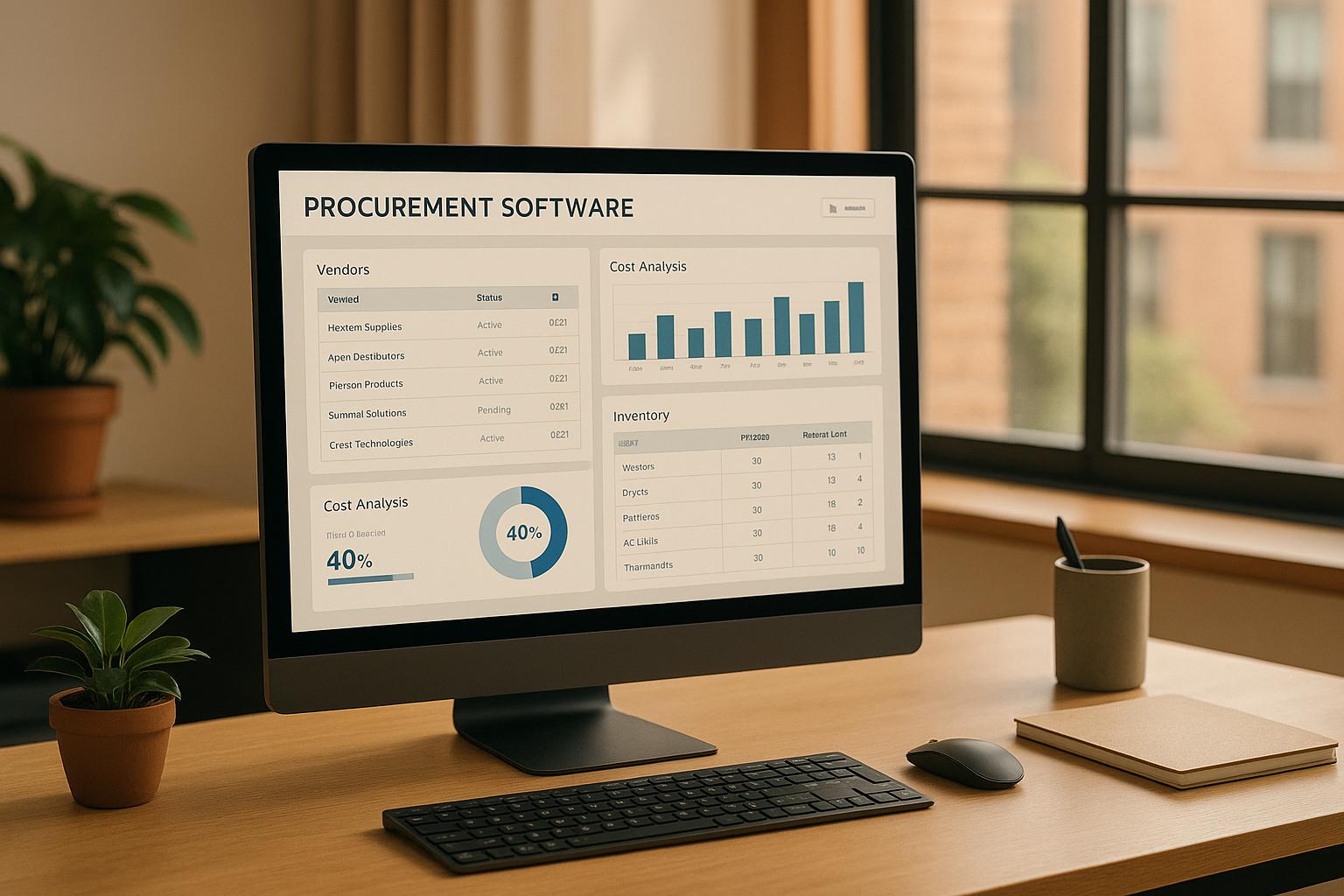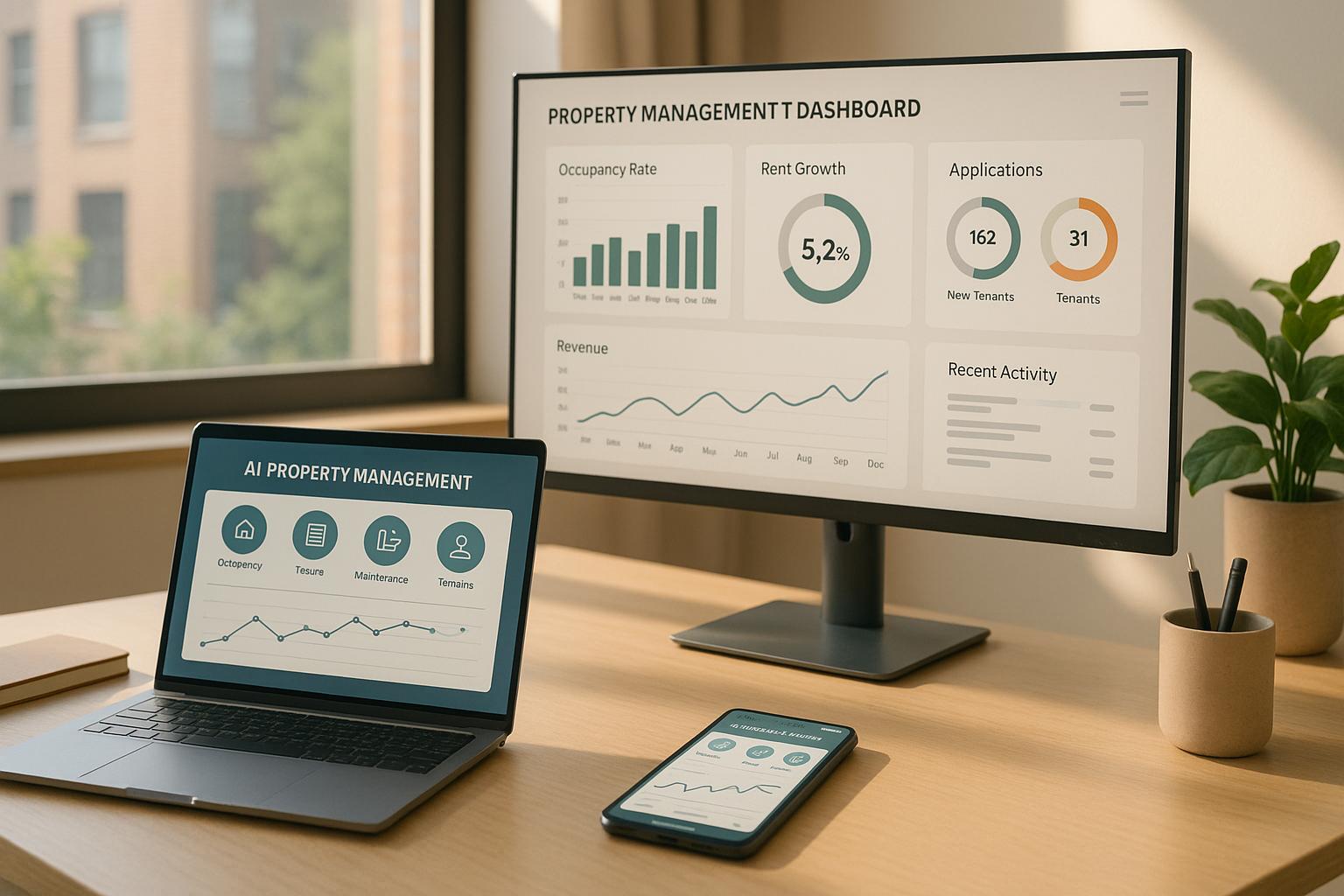- What It Does: Centralizes property management tasks, tracks leads, automates workflows, and enhances tenant experiences.
- Why It's Needed: Manual processes can't keep up with the complexities of large portfolios. Software improves efficiency, reduces errors, and ensures compliance.
- Key Features:
- CRM: Tracks leads, organizes communication, and boosts leasing success.
- Automation: Handles rent reminders, maintenance requests, and lease tracking.
- Listing Syndication: Updates property listings across platforms automatically.
- Analytics: Provides insights on leads, marketing performance, and agent productivity.
- AI Tools: Chatbots assist with inquiries, lead qualification, and tour scheduling.
Benefits:
- Scales effortlessly as portfolios grow.
- Saves time and cuts costs by automating repetitive tasks.
- Improves tenant satisfaction with faster responses and better services.
Choosing the Right Software:
- Look for tools that handle financial management, integrate with existing systems, and meet U.S. compliance standards.
- Test under high usage to ensure reliability and plan for future growth.
Leasing and marketing software isn't just a convenience - it's a necessity for managing large-scale multifamily operations effectively.
5 of the Best Multifamily Property Management Software Solutions
Core Features of Leasing & Marketing Software
Leasing and marketing software combines several tools designed to simplify operations and enhance performance, especially for large multifamily portfolios. These features transform manual processes into streamlined workflows, helping property managers focus on growth and efficiency.
Customer Relationship Management (CRM)
A multifamily CRM serves as the central hub for managing prospect and resident interactions. It tracks communication history, organizes the leasing pipeline, and ensures no leads slip through the cracks - a critical advantage for properties managing hundreds of units.
The benefits are clear. For instance, Salesforce CRM users have reported increases of 30% in sales revenue, 34% in B2B lead volume, and 32% in customer retention [7]. While these stats come from general business use, the principles directly apply to multifamily operations, where effective follow-ups and relationship management drive leasing success.
"Our teams like being able to see everything on one user-friendly dashboard. They have everything they need at their fingertips in one place." - Carrie Bakke, Lund Living [6]
Modern CRMs integrate with email systems, keeping all communications tied to specific prospects or properties. Automation features simplify repetitive tasks like sending lease renewal reminders or following up with prospects who toured but haven’t signed. Additionally, lead management tools track prospects from inquiry to lease signing, giving managers clear insights into conversion rates and bottlenecks. Reporting dashboards provide detailed analytics, such as which marketing channels bring in the highest-quality leads and where teams may need extra support.
"CRM IQ really breaks down the tasks of a leasing specialist in a very simple form." - Arlene Delgado, Highmark Residential [6]
For large portfolios, mobile access is a game-changer. Leasing agents can update notes, respond to inquiries, and view prospect information on the go, meeting the demand for quick responses - 82% of potential renters expect answers immediately when they reach out [8].
Automation Tools
Automation tools take over time-consuming tasks, making them essential for communities with hundreds of units. From sending rent reminders to processing maintenance requests, these features save time and reduce costs.
The impact is substantial. A Buildium survey revealed that 84% of property managers saved significant time thanks to property management software, and 63% reported cost savings as a key benefit [10].
"Buildium is doing so much work for us behind the scenes that we don't have to have someone doing." - Jeannie Connors, VP of Operations & Law Realty Solutions [9]
Automated rent reminders eliminate the need for manual follow-ups, while work order automation generates maintenance requests based on inspections or resident reports. Lease renewal tools send timely notices and track responses, ensuring no renewals are missed. Automation also nurtures prospects with personalized follow-ups via email, text, or calls, based on their behavior and preferences. For large portfolios, this ensures consistent communication without overwhelming staff.
Advanced systems like Funnel's AI can even handle 86% of initial inquiries [5], qualifying leads and addressing routine questions before leasing agents step in.
Listing Syndication
Listing syndication simplifies marketing by automatically distributing property listings across multiple rental platforms. For portfolios with dozens of properties and hundreds of units, this feature saves hours of repetitive work while ensuring maximum exposure.
Listings stay up-to-date across platforms, reflecting changes in availability, pricing, or amenities. This prevents prospects from encountering outdated information and improves the overall experience. Centralized management allows marketing teams to update photos, descriptions, and pricing in one place, with changes automatically applied across all platforms.
For portfolios spanning different markets, syndication tools can tailor listings to local preferences while maintaining consistent branding. This ensures properties remain competitive without requiring separate marketing teams for each region.
Lead Tracking and Analytics
Real-time lead tracking provides a clear picture of where prospects come from, how they interact with marketing materials, and what drives them to become residents. This visibility allows teams to optimize their budgets and processes effectively.
Analytics reveal which marketing channels deliver the best results, helping managers allocate resources wisely. Conversion tracking pinpoints where prospects drop off - whether after a phone call, tour, or application - while performance metrics identify top-performing agents and areas for improvement. These insights ensure consistent service quality and allow successful practices to be replicated across the portfolio. ROI analysis connects marketing efforts directly to lease signings, offering a clear view of what works and where to invest.
AI Chatbots and Interactive Tools
AI chatbots provide instant, 24/7 responses to inquiries, handling common questions about amenities, pricing, and availability without human involvement. They also qualify leads by asking about prospects’ timelines, budgets, and preferences, allowing leasing agents to focus on serious inquiries.
These chatbots can even schedule tours directly, cutting down on back-and-forth communication. For large portfolios, they guide prospects to properties that best match their criteria. Multilingual support makes them even more effective in diverse markets.
As chatbot technology advances, some systems can now handle detailed conversations about lease terms, pet policies, and move-in specials. While they don’t replace human interaction entirely, they ensure prospects receive prompt attention, regardless of the time or day.
Key Benefits of Leasing & Marketing Software for Large Portfolios
Managing large multifamily portfolios comes with its fair share of challenges - tenant communication, lease management, and maintenance coordination can quickly spiral into chaos without the right tools. Leasing and marketing software steps in to transform these hurdles into opportunities, offering several major advantages.
Scalability for Large Operations
When managing hundreds - or even thousands - of units, scalability is non-negotiable. Handling the sheer volume of inquiries, applications, and resident interactions requires more than just manpower. In fact, 76% of multifamily professionals cite operational efficiency as their top challenge[4]. Software designed for large portfolios can handle this complexity with ease. For example, RealPage's AI-powered platform reduced lease processing times by an impressive 75% for Greystar[14], while advanced tools have been shown to speed up unit turnovers by 34%[14].
Manual processes become a liability as portfolios grow, often leading to errors, delays, and missed opportunities[11]. Managing lease expirations across hundreds of units, for instance, is a logistical nightmare without automation. Software solutions can track these dates to minimize vacancy gaps, as demonstrated by Camden Property Trust, which cut vacancy rates by 3% using automated marketing tools[14]. Additionally, property managers save 15–20 hours per week on paperwork with these systems[14], freeing up time for more strategic tasks.
Improved Resident Experience
For large portfolios, delivering a consistent and personalized experience to residents is easier said than done. Software solutions make this possible by standardizing operations and introducing features like predictive maintenance. Properties using these tools report 40% fewer emergency calls[14], which means fewer disruptions for residents. Automated maintenance systems also lead to an 89% boost in tenant satisfaction scores[14], while faster response times - 40% quicker, to be exact - help operators retain 25% more tenants[14].
Efficient workflows reduce not only operational headaches but also tenant disputes. Advanced systems have been shown to save 40% of time and cut tenant conflicts by 60%[14]. These consistent digital experiences can have a significant financial impact. For example, in a 250-unit property with a $1,500 average monthly rent, every 1% increase in turnover can cost roughly $135,000 annually when factoring in vacancy losses and turnover expenses[11]. By improving the resident experience, properties can enhance retention and profitability.
Efficiency and Cost Savings
Streamlined processes also translate into substantial cost savings. Centralized marketing and automated maintenance systems can reduce ad spending by 40%[12] and cut maintenance costs by 28%[14]. Tools like Knock Tours have even been shown to increase lease conversion rates by 63%[13].
"Knock has given us clarity to control costs. Before, we were manually tracking leads and leases from each advertising source and figuring out costs."
- Brian Murphy, Director of Property Management at Aspen Square Management[13]
Proactive maintenance, which is far cheaper than reactive fixes, is another area where these tools shine[11]. Research from REBM Solutions highlights a 40% productivity boost for landlords using comprehensive management systems, enabling teams to handle more units without adding staff[14].
With rising costs for maintenance, utilities, and staffing, large portfolios can turn to technology to drive efficiency. Early adopters of AI-driven features are seeing up to 15% revenue growth through smart pricing strategies[14]. For a 1,000-unit portfolio with an average rent of $1,800, this could mean over $3.2 million in additional annual revenue.
sbb-itb-58157f8
Choosing the Right Leasing & Marketing Software
Picking the right leasing and marketing software for a large multifamily portfolio is no small task. With the property management software market expected to hit $5.51 billion by 2025 [1], making an informed decision is more important than ever.
Key Factors to Consider
Features That Cover All Bases and Scale With Your Needs
Managing 300+ units demands software that can handle a wide range of tasks. Look for platforms offering tools like accounting, online rent collection, tenant portals, maintenance tracking, leasing and screening features, and detailed reporting and analytics [3]. The multifamily property management software market is growing at an impressive 16.3% CAGR from 2025 to 2032 [3], so expect constant improvements in these areas.
Scalability is equally important. The software should be able to handle significant growth, accommodating 10x expansion while supporting over 500 simultaneous users. It should also guarantee fast response times (under 3 seconds) and 99.9% uptime, with room for a 50% increase in users over the next two years [15].
Seamless Integration and Financial Capabilities
Your chosen platform should integrate smoothly with your current financial systems. An API-first approach with support for 50+ third-party integrations is ideal. Additionally, ensure the software complies with financial regulations to avoid operational headaches [2][15].
Ease of Use and Reliable Support
A user-friendly interface minimizes training time and streamlines lease administration [2]. Strong customer support is a must - your team will need guidance during setup and beyond [3]. Also, look for secure document management features to keep lease agreements, contracts, and compliance records organized and easily accessible [2].
Once you've outlined these requirements, it's time to evaluate potential vendors.
Evaluating Vendor Offerings
With your needs defined, the next step is to assess how different vendors stack up.
Testing Under Pressure
Before committing, test the software's performance under peak conditions. Simulate 2–3 times your expected user load to ensure the system maintains response times under 3 seconds, even with 500+ users online at once [15]. This step is crucial - data migration costs for mid-sized operations can range from $15,000 to $75,000 [15], so making the wrong choice can be costly.
Planning for Long-Term ROI
Take a close look at your historical growth trends, including property acquisitions and staffing changes, to anticipate future needs [15]. Make sure the software can handle 3–5 times your current user base, data volume, and transaction levels within the next 18 months [15]. This ensures you're investing in a solution that grows with you.
Importance of US Localization
Localization is a key factor to ensure your software aligns with the operational and legal requirements specific to the United States.
Adapting to Regional Standards
The software should support US-specific settings, such as date formats (MM/DD/YYYY), currency ($USD), and imperial measurement units [16]. This helps ensure compliance with local property management laws and reduces the risk of legal complications [16].
Supporting Common Payment Methods
Your platform must accommodate popular US payment options, including ACH transfers, credit cards, and digital payment systems. This makes rent collection more convenient for tenants [16].
Meeting Legal and Regulatory Standards
The US has a complex web of federal and state data protection laws [17]. Your software needs to comply with these regulations to protect tenant data and avoid legal issues [17].
Smooth Implementation
Plan your implementation carefully. Audit and clean up your data to remove duplicates and fill in missing details. Train your team on features specific to US compliance to ensure a smooth transition [15].
Conclusion: Getting the Most from Leasing & Marketing Software
Investing in the right leasing and marketing software does more than streamline operations - it can redefine how large multifamily portfolios compete and thrive in today’s fast-paced market.
Key Takeaways
Scalability without compromise. Modern platforms are built to handle growth, scaling seamlessly from hundreds to thousands of units. This ensures your software remains a valuable tool as your portfolio expands.
Automation reduces vacancies and administrative burdens. Automating tasks like lease renewals, rent collection, and lead tracking allows your team to focus on activities that directly improve resident satisfaction and retention.
Enhanced resident experiences create an edge. Features like online payments, maintenance portals, and instant communication tools are no longer optional - they’re expected. Properties that integrate these tools see higher satisfaction and retention rates[19][22]. With 88% of multifamily marketers using AI tools daily, adopting these technologies can set your community apart[20].
A RentVision study analyzing over 85,000 leases revealed that communities using integrated marketing tools - such as optimized websites, Google Ads, and automated lead tracking - achieved faster lease conversions and filled vacancies more efficiently[18]. These tools not only improve engagement but also ensure marketing budgets are used effectively.
With these insights, the next step is clear: turn this knowledge into actionable strategies.
Next Steps
Pinpoint your current challenges. Look closely at areas where manual processes consume too much time, where communication gaps exist, or where potential residents drop off during the leasing process. These pain points will help define the features your software should prioritize.
Explore and test solutions that fit your portfolio’s needs. Focus on platforms with strong CRM tools, marketing automation, listing syndication, and in-depth analytics. Ensure the software meets US-specific standards, like USD currency formatting, MM/DD/YYYY date formats, and compliance with local regulations[21]. Run demos under real-world conditions to assess ease of use and performance during busy times.
Plan for tomorrow, not just today. Experts anticipate AI evolving from task-specific roles to managing entire workflows, making leasing and marketing processes even more seamless[20]. Choose a platform that’s not just functional now but is also committed to staying ahead of industry trends.
As the multifamily sector continues to consolidate, staying informed about advancements and choosing a forward-thinking software partner will help ensure your operations remain efficient and competitive for years to come.
FAQs
How does leasing and marketing software help improve tenant satisfaction and retention in large multifamily communities?
Leasing and marketing software plays a key role in keeping tenants happy and encouraging them to stay longer. By streamlining communication, offering personalized interactions, and automating repetitive tasks, these tools make life easier for both property managers and tenants.
Features like CRM systems, AI-powered chatbots, and lead tracking tools help property teams build better relationships with tenants. Automation ensures quicker responses and fewer mistakes, creating a smoother experience from the first inquiry to ongoing support. This kind of efficiency builds trust and loyalty, which are crucial for retaining residents, especially in larger multifamily properties.
What should property managers consider when choosing leasing and marketing software for large multifamily portfolios?
When choosing leasing and marketing software for a growing multifamily portfolio, it's crucial to focus on tools that can grow alongside your business. Features like a dependable CRM, automation tools, and lead tracking are essential for managing the demands of larger communities. You'll also want software that integrates smoothly with your current systems, offers an easy-to-navigate interface, and provides strong reporting and analytics to keep operations running efficiently.
On the marketing side, look for advanced capabilities like AI-powered chatbots, syndication tools, and options for managing multiple properties. It’s also important to ensure the software complies with local regulations and is designed to scale with your portfolio while keeping workflows simple and effective.
How do AI chatbots and automation tools improve efficiency in managing large multifamily properties?
AI chatbots and automation tools are changing the game in property management by taking over tedious tasks and boosting responsiveness. These tools can manage routine questions, schedule property tours, handle maintenance requests, and even assist with lease management - all while being available around the clock. This means faster communication with both potential and current residents, cutting down delays and improving overall satisfaction.
By automating repetitive tasks, property managers can dedicate their energy to more critical responsibilities, such as streamlining operations and building stronger tenant relationships. In the end, these technologies save time, enhance productivity, and help large multifamily properties run more smoothly.


